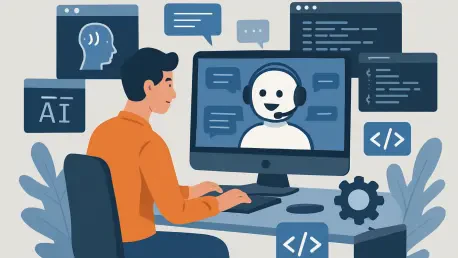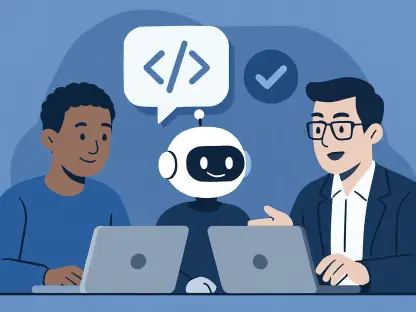Today, we’re thrilled to sit down with Vijay Raina, a renowned expert in enterprise SaaS technology and software design. With his deep expertise in tools and architecture, Vijay has been at the forefront of integrating innovative solutions into complex workflows. In this conversation, we dive into the transformative potential of AI agents, exploring how they’re reshaping developer experiences, streamlining tool interactions, and redefining user interfaces through natural language. We also touch on the challenges and opportunities that lie ahead in building a cohesive agentic future.
How have you seen the transition from chatbots to AI agents unfold in the tech landscape over recent years?
I’ve watched the shift from chatbots to AI agents with a lot of interest. A few years back, chatbots were the big thing—simple, rule-based systems or early machine learning models that handled basic customer queries. But AI agents represent a leap forward. They’re not just responding to prompts; they’re proactive, capable of reasoning, tool use, and even decision-making. This shift is driven by advancements in large language models and a growing demand for automation that goes beyond scripted interactions. Agents can integrate into workflows in ways chatbots never could, acting as true assistants rather than just conversational tools.
What specific problems do AI agents solve when it comes to context switching for developers and knowledge workers?
Context switching is a real productivity killer. Developers, for instance, often juggle multiple tools, notifications, and tasks, which can shatter their focus. AI agents help by acting as a central hub, pulling in relevant information from various sources and presenting it without forcing users to jump between apps. They reduce the mental load of remembering where data lives or which tool does what. By anticipating needs and automating small but frequent tasks, agents help maintain that coveted flow state, letting workers stay immersed in their core work rather than getting bogged down by distractions.
There’s a concept floating around that ‘AI isn’t the app, it’s the UI.’ How do you interpret this idea in the context of AI agents?
I think it’s a brilliant way to frame AI’s role. The idea is that AI, especially through agents, becomes the primary way we interact with technology, rather than being just another application. Agents take this further by serving as a natural language interface to everything in your digital ecosystem. Instead of navigating clunky menus or learning specific software, you just say what you want, and the agent handles the rest. This single point of access simplifies everything—imagine controlling your entire suite of tools through one conversational window. It’s a game-changer for usability and efficiency.
Looking at the history of user interfaces, how do you view the return to text-based interactions with AI agents compared to earlier systems like MS-DOS?
It’s fascinating how we’ve come full circle from text-based terminals to graphical interfaces and now back to text with AI agents. The key difference is accessibility. Old systems like MS-DOS required knowing specific commands—almost a secret language. With AI agents, you just type or speak in plain English, and they interpret your intent. This lowers the barrier to entry significantly. While it doesn’t eliminate the need for technical expertise entirely, it does democratize access to complex tools, letting non-experts interact with technology in a way that feels intuitive.
AI agents are said to connect disparate software through tools and APIs. Can you unpack how this capability transforms workflows?
This is one of the most exciting aspects of AI agents. They can act as orchestrators, using APIs to bridge different software systems and create a seamless experience. For example, an agent might pull data from a database, analyze it with another tool, and then push results into a reporting app—all without manual intervention. This makes them a central entry point for workflows, reducing the need to toggle between platforms. However, challenges like standardizing access across diverse tools and ensuring secure integrations remain. It’s not plug-and-play yet; there’s a lot of behind-the-scenes work to make these connections reliable.
Developers often struggle with managing multiple tools. How can AI agents alleviate this burden?
The sheer number of tools developers use today—CI/CD pipelines, testing frameworks, security scanners—can be overwhelming. Studies suggest they lose hours each week just switching between them. AI agents can simplify this by acting as a unified interface, where a developer can request actions or insights without leaving their primary workspace, like an IDE or terminal. They can also help with onboarding to new tools by summarizing documentation or automating setup processes. This cuts down on learning curves and lets developers focus on writing code rather than wrestling with tool sprawl.
What’s your perspective on AI agents assisting with system design, particularly in identifying components or dependencies?
I’m optimistic but cautious about this. AI agents can absolutely provide a first pass at system design by mapping out dependencies, suggesting modular components, or flagging potential integration issues based on existing documentation or codebase analysis. For large enterprises with sprawling systems, this can save a ton of time during initial planning. However, they’re not a replacement for human oversight. Complex projects still need stakeholder input and rigorous review. Agents are best as collaborators—handling the grunt work of scoping while architects focus on strategy.
What’s your forecast for the future of AI agents in shaping developer workflows and enterprise technology?
I believe AI agents will become indispensable in the coming years, evolving into core components of developer workflows and enterprise tech stacks. We’re likely to see them embedded deeper into platforms like terminals and IDEs, acting as personalized assistants that adapt to individual work styles. On the enterprise side, I expect a push toward robust agentic platforms that prioritize security, governance, and data management. While there’s hype to temper, the trajectory is clear: agents will reduce friction and amplify productivity, provided we invest in the infrastructure to support them. It’s an exciting space to watch.









